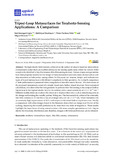Mostrar el registro sencillo del ítem
Tripod-loop metasurfaces for terahertz-sensing applications: a comparison
| dc.creator | Jáuregui López, Irati | es_ES |
| dc.creator | Orazbayev, Bakhtiyar | es_ES |
| dc.creator | Pacheco-Peña, Víctor | es_ES |
| dc.creator | Beruete Díaz, Miguel | es_ES |
| dc.date.accessioned | 2020-09-18T08:50:54Z | |
| dc.date.available | 2020-09-18T08:50:54Z | |
| dc.date.issued | 2020 | |
| dc.identifier.issn | 2076-3417 | |
| dc.identifier.uri | https://hdl.handle.net/2454/38152 | |
| dc.description.abstract | The high electric field intensity achieved on the surface of sensors based on metasurfaces (metasensors) makes them an excellent alternative for sensing applications where the volume of the sample to be identified is tiny (for instance, thin-film sensing devices). Various shapes and geometries have been proposed recently for the design of these metasensors unit-cells (meta-atoms) such as split ring resonators or hole arrays, among others. In this paper, we propose, design, and evaluate two types of tripod metasurfaces with different complexity in their geometry. An in-depth comparison of their performance is presented when using them as thin-film sensor devices. The meta-atoms of the proposed metasensors consist of a simple tripod and a hollow tripod structure. From numerical calculations, it is shown that the best geometry to perform thin-film sensing is the compact hollow tripod (due to the highest electric field on its surface) with a mean sensitivity of 3.72 × 10−5 nm−1. Different modifications are made to this structure to improve this value, such as introducing arms in the design and rotating the metallic pattern 30 degrees. The best sensitivity achieved for extremely thin film analytes (5–25 nm thick) has an average value of 1.42 × 10−4 nm, which translates into an extremely high improvement of 381% with respect to the initial hollow tripod structure. Finally, a comparison with other designs found in the literature shows that our design is at the top of the ranking, improving the overall performance by more than one order of magnitude. These results highlight the importance of using metastructures with more complex geometries so that a higher electric field intensity distribution and, therefore, designs with better performance can be obtained. | en |
| dc.description.sponsorship | This research was funded by Spanish Ministerio de Ciencia, Innovación y Universidades, Project RTI2018-094475-B-I00 (MCIU/AEI/FEDER,UE). | en |
| dc.format.extent | 9 p. | |
| dc.format.mimetype | application/pdf | en |
| dc.language.iso | eng | en |
| dc.publisher | MDPI | en |
| dc.relation.ispartof | Applied Sciences 2020, 10, 6504 | en |
| dc.rights | © 2020 by the authors. Licensee MDPI, Basel, Switzerland. This article is an open access article distributed under the terms and conditions of the Creative Commons Attribution (CC BY) license. | en |
| dc.rights.uri | http://creativecommons.org/licenses/by/4.0/ | |
| dc.subject | Metasensors | en |
| dc.subject | Metasurfaces | en |
| dc.subject | Sensing | en |
| dc.subject | Terahertz | en |
| dc.subject | Thin-film | en |
| dc.subject | Tripod | en |
| dc.title | Tripod-loop metasurfaces for terahertz-sensing applications: a comparison | en |
| dc.type | Artículo / Artikulua | es |
| dc.type | info:eu-repo/semantics/article | en |
| dc.contributor.department | Ingeniería Eléctrica, Electrónica y de Comunicación | es_ES |
| dc.contributor.department | Ingeniaritza Elektrikoa, Elektronikoa eta Telekomunikazio Ingeniaritza | eu |
| dc.contributor.department | Institute of Smart Cities - ISC | es |
| dc.rights.accessRights | Acceso abierto / Sarbide irekia | es |
| dc.rights.accessRights | info:eu-repo/semantics/openAccess | en |
| dc.identifier.doi | 10.3390/app10186504 | |
| dc.relation.publisherversion | https://doi.org/10.3390/app10186504 | |
| dc.type.version | Versión publicada / Argitaratu den bertsioa | es |
| dc.type.version | info:eu-repo/semantics/publishedVersion | en |




